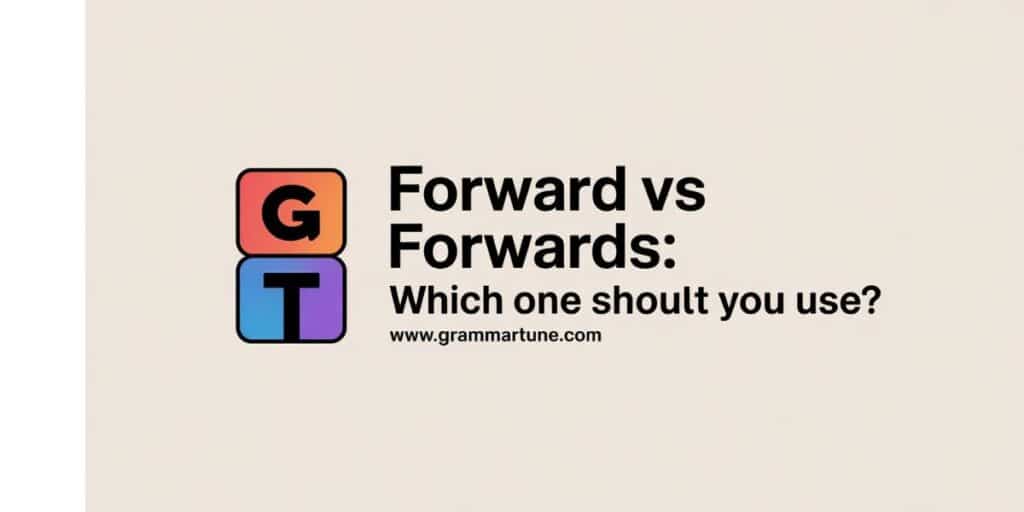Forward vs Forwards—what’s the difference, and when should you use each? These two words may look almost identical, but they play slightly different roles in sentences. While many use them interchangeably, there’s a subtle shift in meaning and usage depending on context.
Understanding the correct form can sharpen your writing and prevent confusion. In this guide, you’ll learn the distinction, backed by grammar rules and real-life examples. We’ll explore direction, movement, grammar usage, and common English phrases—all to help you confidently choose between Forward and Forwards every time.
📚 Table of Contents
🔍 Understanding the Basics
- ❓ Why is There Confusion?
- 📘 What Does the Word “Forward” Mean?
- 📗 What Does the Word “Forwards” Mean?
- 🔎 “Forward” vs. “Forwards”: The Differences
- 🌍 Usage in Different English Variants
- 📖 Common Contexts Where Each Is Used
- 🇬🇧 British English Words Ending in ‘s’ vs American English
- ✍️ Examples of “Forward” and “Forwards” in Sentences
- 🧠 Practical Use & Tips
- 📝 Sentences Using “Forward”
- 📝 Sentences Using “Forwards”
- ✅ Which One Should You Use: “Forward” or “Forwards”?
- 📋 General Guidelines
- 💡 Tips for Writers
- 🔁 Synonyms of “Forward” and “Forwards”
- 🧬 Origins of “Forward” and “Forwards”
- ⚡ Quick Summary
- 📌 Conclusion: Forward vs Forwards – Which One Should You Use?
- 🙋♂️ FAQs
Why is There Confusion?
Both forward and forwards look and sound nearly the same.
People often assume they’re interchangeable without checking.
But in writing, that small s can change the tone or flow.
Language changes over time and by region.
Grammar rules also play a role in the confusion.
Add in modern usage, and it’s easy to see why it trips people up.
Must read: Understanding How “Run” Changes in the Past and Past Participle
⚡ Quick Summary: Forward vs Forwards
- Forward is more common in American English and used as an adjective, adverb, verb, or noun.
- Forwards is mainly used in British English and functions strictly as an adverb.
- Both mean movement in a direction, usually ahead—but forward is more versatile.
✅ Use forward in emails, business, tech, and formal writing.
✅ Use forwards in British writing, storytelling, or casual scenes.
🎯 When in doubt, stick with forward—it’s safer and fits more contexts.
What Does the Word “Forward” Mean?
Forward typically works as an adjective or adverb.
It describes movement in a particular direction—usually ahead.
You’ll also find it used in business and tech language.
It can also be a verb, like when you forward an email.
In these cases, it’s tied to action or progress.
The word has a sleek, modern vibe to it.
What Does the Word “Forwards” Mean?
Forwards is mostly used as an adverb in British English.
It shows direction, just like forward, but feels more casual.
You’ll rarely see it used as a verb or noun.
It adds a slightly old-fashioned or regional tone.
Writers often choose it to match the voice or setting.
Think of it like afterwards or towards—same kind of style.
“Forward” vs. “Forwards”: The Differences
Forward leans formal and flexible—adjective, verb, noun, adverb.
Forwards is strictly an adverb and usually British.
They point in the same direction, just with different grammar rules.
In American English, forward dominates nearly every use.
In British English, forwards pops up more often.
So the choice often depends on where and how you’re writing.
Usage in Different English Variants
Americans almost always use forward—in every context.
It fits naturally in business, sports, and daily speech.
Even when speaking casually, the s gets dropped.
In the UK, forwards still hold ground.
You’ll see it in newspapers, books, and conversations.
Both are correct—it just depends on which side of the ocean you’re on.
Common Contexts Where Each Is Used
In tech or email, people say, “I’ll forward this to you.”
In sports: “He passed the ball forward.”
Formal writing almost always uses forward too.
Forwards shows up in storytelling or older literature.
“He stepped forwards into the fog” has a moody feel.
British writers also use it in descriptive scenes.
British English Words Ending in ‘s’ vs American English
This British English loves those extra s endings: towards, backwards, forwards.
They add a rhythmic, almost poetic flow.
It’s more tradition than rule, but it sticks.
American English cuts the s to keep things crisp.
Toward, backward, and forward all follow this pattern.
It’s just a simpler style—cleaner and more direct.
You will like: Igniter or Ignitor: Which Spelling Should You Choose?
Examples of “Forward” and “Forwards” in Sentences
She leaned forward to hear better.
The team moved forward with the plan.
I’ll forward the document this afternoon.
He stepped forwards into the light.
The dog ran forwards, chasing the ball.
She looked forwards to the trip all week.
Sentences Using “Forward”
Let’s push the deadline forward by two days.
He drove the car forward out of the garage.
They’re moving forward with construction next month.
Sentences Using “Forwards”
The child walked forwards into the room.
She looked forwards to meeting her friend.
He moved forwards, unaware of the danger.
Which One Should You Use: “Forward” or “Forwards”?
If you’re writing for an American audience—stick with forward.
It’s cleaner, more accepted, and works in more cases.
Only use forwards if the tone or region calls for it.
British writers may prefer forwards in casual writing.
But even there, forward shows up more and more.
Know your audience, then choose accordingly.
General Guidelines
Use forward for emails, business writing, and most modern text.
Stick with it unless there’s a strong reason to go old-school.
It’s more versatile and less distracting.
Choose forwards for narrative writing with a British tone.
It fits certain voices or genres better.
But don’t force it—it can feel awkward if overused.
Tips for Writers
When in doubt, go forward—especially in US English.
Check the tone and flow of your sentence.
Reading it out loud can help spot what sounds natural.
Also, match your usage to the rest of your text.
Consistency matters more than being “technically” right.
If you start with forward, stick with it throughout.
Synonyms of “Forward” and “Forwards”
Sometimes, variety makes your writing stronger.
Using synonyms keeps it fresh and avoids repetition.
Here are a few for each version.
Synonyms of “Forward”:
- Ahead
- Onward
- Forth
- Advancing
- Straight ahead
Synonyms of “Forwards”:
- Onwards
- Progressively
- Ahead
- Forth
- Step by step
Origins of “Forward” and “Forwards”
Both words trace back to Old English roots.
Forward comes from “foreweard”—meaning “toward the front.”
Forwards simply evolved as an adverbial form later.
Over centuries, regional habits shaped their use.
British English held onto forwards, while Americans streamlined it.
The base meaning, though, has stayed pretty much the same.
You will like: What’s the Plural of Software? Is it Software or Softwares?
Conclusion
When it comes to Forward vs Forwards, both words point in the same direction—just with slightly different roles. Forward is the more flexible and widely accepted choice, especially in American English. Forwards adds a regional or literary touch, often seen in British writing.
The key is knowing your audience and keeping your tone consistent. If you’re aiming for clarity, professionalism, or modern usage, forward is your best bet. But for storytelling or British flavor, forwards can still have its place.
FAQ’S
Can I use “forward” and “forwards” interchangeably?
Not always. While both suggest movement ahead, forward is more versatile and widely accepted, especially in American English. Forwards is more common in British English and used only as an adverb.
Is “forward” more formal than “forwards”?
Yes. Forward tends to sound more formal and modern, while forwards feels more casual or traditional—often found in fiction or UK-based writing.
Which should I use in professional writing?
Always use forward in business, technical, or academic contexts. It reads cleaner, sounds more polished, and fits better in formal writing.
Do Americans ever use “forwards”?
Rarely. In the U.S., forward is the go-to form. Using forwards in American writing can feel awkward or outdated.
Why does British English add “s” to words like forwards, backwards, and towards?
It’s mostly historical and stylistic. British English retains the older adverbial -s endings, while American English simplifies them by dropping the s.

Joulia, a seasoned wordsmith and grammar enthusiast, brings over a decade of blogging expertise to Grammar Tune. With a keen eye for linguistic precision and a passion for making complex grammar concepts accessible, he has helped thousands of readers enhance their writing skills. His engaging teaching style and practical approach to language learning have made him a trusted voice in the online grammar community.







